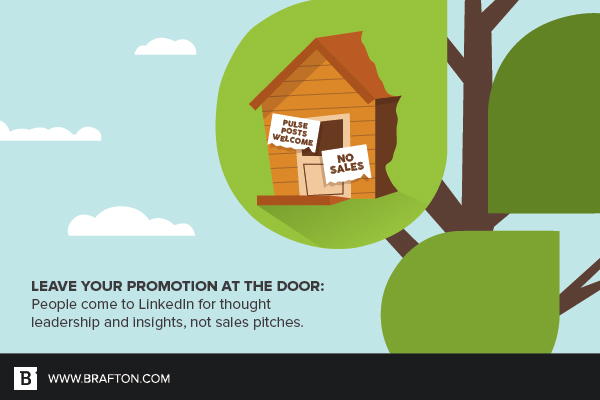Since its introduction a few years ago, LinkedIn Pulse has provided business professionals in all industries with an additional – and effective – platform for sharing their insight, thought leadership and analysis with their connections and the network as a whole.
But what makes Pulse so special, and how can it benefit your brand? After all, only individual users can post content on the platform.
In short, Pulse helps professionals get their own content and their company in front of the right people, allowing them to build their connection base and their personal brand.
And by proxy, Pulse gives organizations a new way to push content out to their target audience, which ultimately contributes to lead generation.
Brafton’s Manager of Social Media Allie Stone says that by creating content for LinkedIn and using Pulse, brands can build trust and stand out from others in their industry. Which is something all marketers should aim to accomplish.
“Because everyone’s LinkedIn feed is saturated with company updates, it is powerful to have some branded content from a professional’s personal profile,” she explains. “That person’s opinion is valued and trusted, which makes the company seem more credible. It also helps the company name break through the noise.”
Pulse revives the LinkedIn publishing flatline
LinkedIn Pulse has grown significantly as a marketing tool since the feature was rolled out to all users in 2014.
As of 2015, there were more than 3 million posts on LinkedIn Pulse, making it one of the largest and fastest-growing publishing platforms for professionals. At that point, more than 130,000 posts were being created each week, and an average piece of content distributed through Pulse reached readers in more than 20 industries across nine countries. So, if that trend has continued to this day (we couldn’t find more recent data, unfortunately), you can only imagine how hugely popular the platform is for finding informative and opinionated content in 2017.

Hitting the right beat on Pulse
Crafting content for LinkedIn shares many similarities to writing blogs for your own site. But to be successful on this platform, you need to be aware of the key differences. To help you ensure your LinkedIn Pulse posts resonate with and engage your audience – and not to mention draw in traffic to your site – we recommend the following techniques:
1. Don’t be promotional
This is probably one of the most important factors when it comes to content for LinkedIn. Because of the nature of the platform, pieces that heavily push a product or service aren’t going to pick up steam. People on LinkedIn want content that is educational and newsworthy, not pieces that are trying to sell them something.
2. Use keywords
Including keywords helps readers find your content when using LinkedIn’s search function. Make use of the keyword tag function in Pulse to get your content in front of prospects who are looking for specific information on the network.
3. Craft clickable headlines
If you want prospects on LinkedIn to read your article, give them a headline that entices them to click. The title should offer insight into what your content is about, but still leave room for readers to want more. Also, avoid clickbait headlines. They’re out of style and won’t get you any views.
4. Aim for longer-form content
Your LinkedIn readers are accessing your content because they want detailed analyses and insights from experts. So give them what they want in each piece you produce – the best word range to aim for is 1,900 to 2,000 words. This gives you plenty of room to dive deep into a topic to fully explore it and provide valuable information to your audience.
5. Make it engaging and easy to read
Don’t let the fact that LinkedIn is a professional network throw you off. Your content shouldn’t be stodgy, filled with too much jargon or just blocks of text. Use a tone that is engaging yet authoritative, and experiment with formatting.
Allie recommends using lists, subheadings and how-to formats, as well as visuals. Including pictures, graphics, pull quotes and other visual features will help make your content pop and, often literally, illustrate your topic. Embeds are another feature you can add to make your content pop. YouTube videos and Slideshares are great examples of how you can incorporate more visual elements to support your post and engage your readers.
6. Link back to your website
Even though your content should not be promotional, you can still link back to your website. Just do so in a subtle way. For instance, you can frame a link as an informal call to action that tells the reader they can head to your website if they want more information. This guides them to the next step of the process without pressuring them to make a decision on your product or service.
You can also include a short blurb about the author at the end of each post to provide more information and subtly guide your readers to your website.
7. Don’t ignore your LinkedIn profile
If you’re going to take the time to create content for LinkedIn, you can’t neglect your profile. Allie explains that an inactive profile could turn prospects off from your brand after reading a post.
“Your profile should be active, updated and well-kept,” she says. “People will want to connect and will come to your profile to find out more about you and your business. If it’s not updated or active, it looks bad.”
LinkedIn Pulse is geared to become even more prominent in the world of B2B marketing this year, so use these tips to start creating content that will help you take your LinkedIn community by storm.





